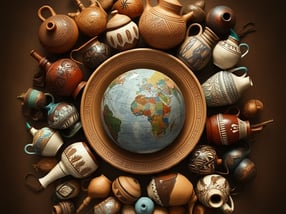Free shipping for all orders Limited Time Offer
Pottery as an Expression of Cultural Identity
CULTURE & HERITAGE
OUAKILI RADOUANE
11/5/2024


Pottery has been integral to human culture for millennia, fulfilling both functional and artistic roles. Every clay item narrates a tale, embodying the traditions, convictions, and surroundings of the people who produced it. The elaborate blue and white motifs of Chinese porcelain represent the unity of nature and craftsmanship, while Native American pottery often has symbols and patterns that illustrate the spiritual connection between individuals and the earth. When visitors buy these antiques, they get not just a beautiful object but also a symbol of the region's legacy.
The exchange of cultural symbols surpasses linguistic obstacles, enabling people to engage with cultures they may not have encountered otherwise. Through the appreciation and exhibition of ceramics from remote regions, individuals participate in a tacit discourse that cultivates curiosity and reverence for difference. A vase from Turkey or a terracotta pot from India, shown in a living room in Europe or America, may initiate discussions that foster a deeper inquiry and comprehension of the culture it represents.
The Function of Tourists in Cultural Exchange
Tourists serve as emissaries of cultural exchange, bringing fragments of global cultures to their locales. Purchasing pottery from local craftsmen not only sustains traditional craftsmanship but also contributes to the dissemination of cultural heritage. A handmade bowl from Japan may exemplify the precise skill and passion of Japanese artists to those in other countries. The purchaser often unwittingly advocates for the culture, recounting their vacation experiences and the importance of the item to friends and family.
Furthermore, the worldwide dissemination of these cultural objects contributes to the preservation of traditional art forms in an age of mass manufacturing. Visitors' financial assistance enables artists to sustain their profession and transmit their abilities to subsequent generations. The symbiotic interaction between visitors and artists guarantees the preservation of distinct cultural identities that may otherwise be diminished by industrialization.
Pottery as a Vehicle for Cultural Expression
In contrast to other art forms, pottery fulfills a dual function. It serves as both a functional item and a medium for cultural storytelling. A solitary ceramic item may encapsulate centuries of tradition, reflecting a group's aesthetic principles, rituals, and historical narrative. The Berber pottery of North Africa, distinguished by its geometric designs and earthy hues, embodies the region's extensive history and nomadic culture. Likewise, the vibrant hues and energetic patterns of Mexican Talavera ceramics narrate the amalgamation of indigenous and Spanish influences.
When travelers return with such objects to their nations, they foster a cultural discussion that transcends continents. These relics often integrate into daily life, assimilating into new cultural contexts while preserving their original importance. A Moroccan tagine used in a French kitchen serves as a cooking vessel and a symbol of the interrelation between culinary and cultural traditions. Such conversations underscore the universality of human invention and the collective appreciation for aesthetics and utility.
The Influence on Worldwide Cultural Consciousness
The proliferation of pottery as a cultural item significantly influences worldwide cultural consciousness. Introducing individuals to the creative traditions of several nations aids in dismantling prejudices and misunderstandings. It cultivates a respect for variety, prompting people to see the world as a mosaic of interconnected histories and customs. This comprehension is especially crucial in the contemporary worldwide society, where cultural appreciation may serve as a counterweight to the homogenizing impacts of modernity.
Moreover, ceramics may act as a conduit for profound involvement with a culture. A visitor purchasing a traditional Greek amphora may be motivated to explore ancient Greek history, mythology, or the methodologies used in crafting such objects. Likewise, an individual who receives a gift of Korean celadon ceramics may investigate the historical context of the Goryeo Dynasty and its impact on East Asian art. Thus, pottery transcends mere decoration; it catalyzes cultural research and teaching.
Obstacles and Prospects
The worldwide dissemination of pottery offers significant cultural advantages, however it also presents obstacles. The commercialization of traditional crafts may result in a loss of authenticity, as artists modify their goods to satisfy foreign market expectations. The pressure to cater to a worldwide audience may diminish the cultural importance of the objects. It is crucial to maintain a balance between safeguarding historic workmanship and addressing the requirements of a contemporary audience.
Nonetheless, these problems also provide possibilities. Initiatives that advocate for ethical tourism and support fair trade may guarantee equitable compensation for craftsmen and the preservation of their cultural legacy. Museums, exhibits, and educational programs may enhance the cultural significance of pottery, offering forums for artists to disseminate their narratives and skills to a broader audience.
Final Assessment
Pottery functions as a significant medium for disseminating culture worldwide, promoting comprehension and appreciation among many nations. When visitors purchase ceramics, they get more than just things; they obtain fragments of history, craftsmanship, and identity that enhance a worldwide discourse of cultural exchange. This technique enhances individual lives while preserving and honoring traditional crafts. In an increasingly linked world, the simple act of acquiring pottery signifies a powerful expression of togetherness, respect, and common humanity. By acknowledging and endorsing the cultural importance of pottery, we may foster international connections and appreciate the variety that enriches our world.


